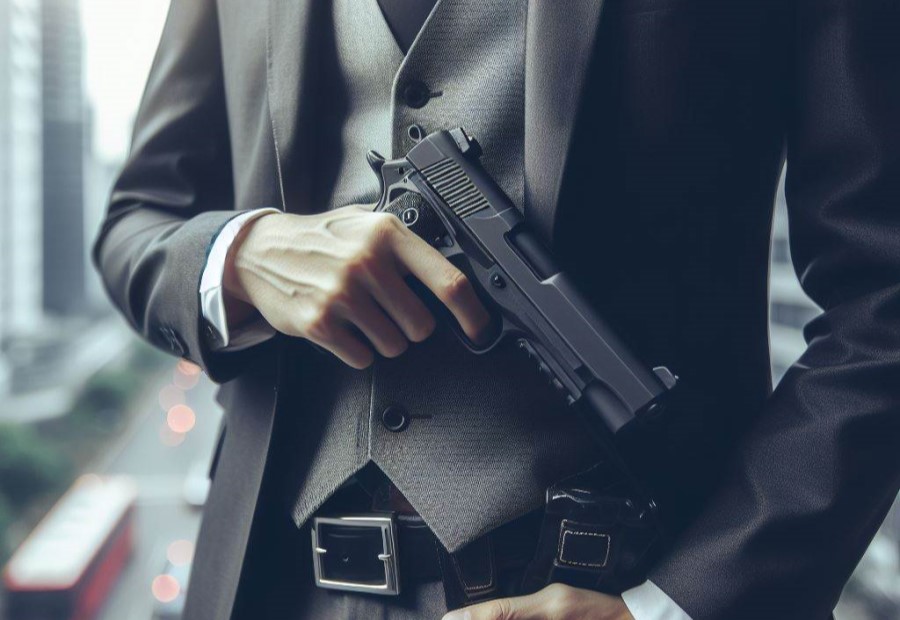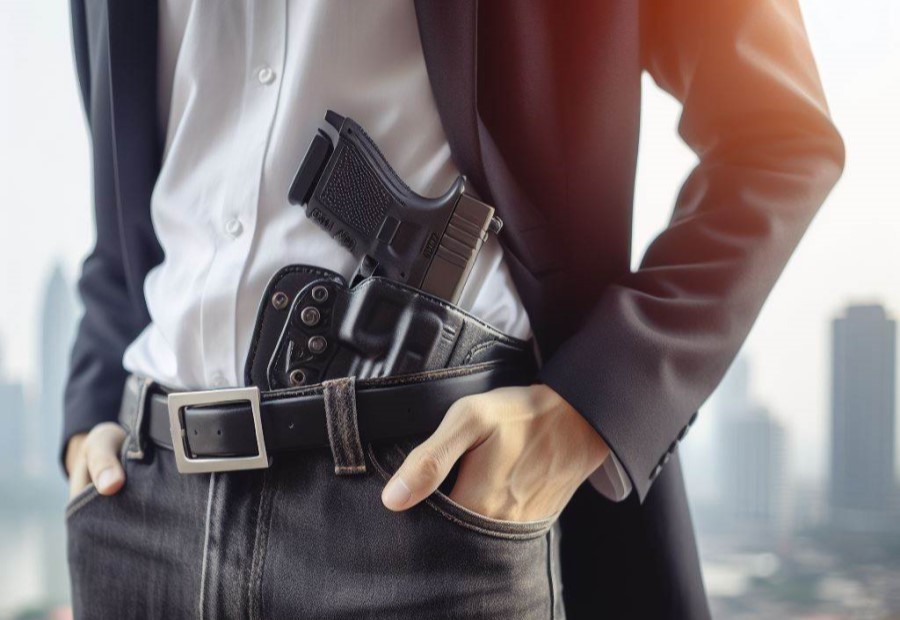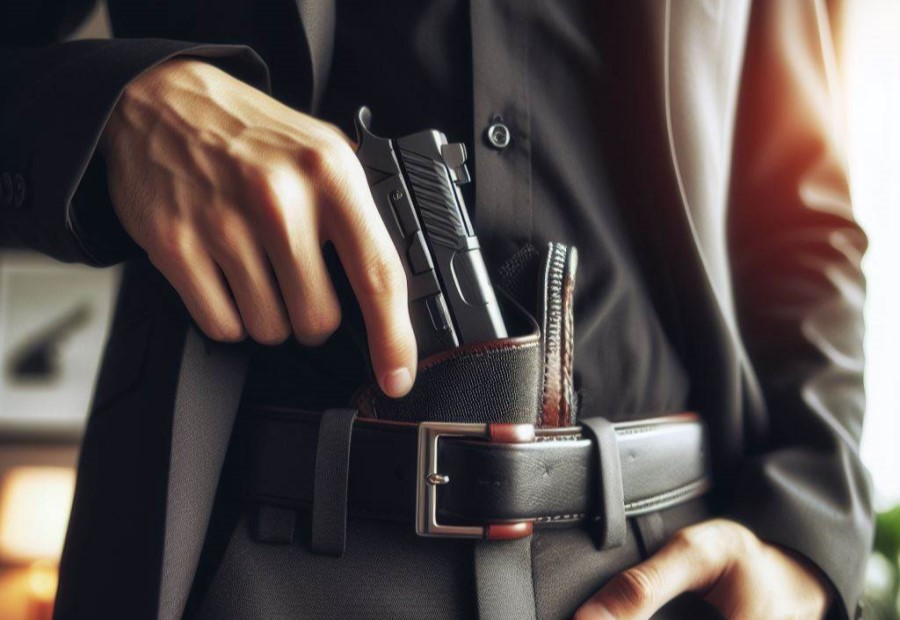Wearing a holster with a suit is a unique and specialized requirement that may arise for various reasons, such as personal protection or professional obligations. It is essential to understand the proper ways to wear a holster with a suit to ensure both comfort and functionality.
In this article, we will explore the nuances of wearing a holster with a suit, including the reasons one might need to do so and the considerations for choosing the right holster. We will also provide valuable tips on properly wearing and concealing a holster with a suit, as well as safety considerations and legal aspects to keep in mind.
Whether you are a law enforcement officer, security personnel, or someone interested in concealed carry, this guide will provide you with the information you need to navigate wearing a holster with a suit successfully.
Why Would You Need to Wear a Holster with a Suit?

Let’s uncover the reasons behind this unlikely combination. From personal protection through concealed carry to meeting the professional requirements of law enforcement or security personnel, we’ll dive deep into the contrasting yet interconnected sub-sections.
So, whether you’re concerned about safety or simply need to meet the demands of your job, wearing a holster with a suit is a topic worth exploring.
Get ready for some surprising insights!
1. Concealed Carry for Personal Protection
When considering concealed carry for personal protection while wearing a suit, there are several factors to keep in mind:
- Legal requirements: Familiarize yourself with local laws and regulations concerning concealed carry for personal protection. Different jurisdictions may have different rules and restrictions.
- Holster type: Choose a holster that is suitable for wearing with a suit, such as an inside waistband or outside waistband holster, for concealed carry for personal protection. The holster should provide secure retention of the firearm.
- Comfort and accessibility: Ensure that the holster is comfortable to wear for extended periods and allows for easy access to the firearm when needed for concealed carry for personal protection. Adjustable retention systems and adjustable cant angles can enhance comfort and accessibility.
- Proper fit and adjustment: The holster should fit properly and securely on your body, without any movement or shifting, for concealed carry for personal protection. Make sure to adjust the holster’s position and retention to your preference.
- Practice drawing and reholstering: Regularly practice drawing your firearm from the holster and reholstering it safely for concealed carry for personal protection. This will help you become familiar with the process and improve your speed and accuracy.
By considering these factors, you can ensure that you are well-prepared and equipped for concealed carry for personal protection while wearing a suit.
Remember, always prioritize safety and adhere to the laws and regulations in your area.
2. Professional Requirements for Law Enforcement or Security Personnel
Professional requirements for law enforcement or security personnel who need to wear a holster with a suit include:
- Concealed carry for personal protection is a crucial requirement for professionals in law enforcement or security. Carrying a firearm discreetly and securely in a holster allows them to have quick access to their weapon if needed.
- Meeting the dress code and uniform standards is essential for professionals in these fields. Wearing a suit with a properly positioned and concealed holster ensures that they maintain a professional appearance while fulfilling their safety obligations.
- Adhering to department policies and regulations is necessary to ensure compliance and prevent any potential safety or legal issues. Professionals need to be familiar with their organization’s guidelines regarding holster usage, proper concealment, and firearm handling.
- Regular training and practice in drawing and reholstering are essential. Law enforcement and security personnel must stay proficient and confident in their firearm skills to respond effectively and responsibly in any situation.
- Maintaining proper trigger discipline and firearm handling is vital for safety. Professionals with holsters must cultivate good habits to prevent accidental discharges or mishandling of their firearms.
For law enforcement or security personnel, wearing a holster with a suit presents unique challenges and responsibilities. Following these professional requirements ensures that they can fulfill their duties effectively while maintaining a professional and safe environment.
Choosing the Right Holster for Wearing with a Suit

When it comes to wearing a holster with a suit, choosing the right one is essential. In this section, we’ll explore the factors to consider when selecting a holster that seamlessly blends with your formal attire.
From the type of holster, whether it’s inside or outside the waistband, to material and design considerations, and ensuring comfort and accessibility, we’ll guide you through the process of finding the perfect holster that ensures both style and functionality.
1. Consider the Type of Holster: Inside Waistband or Outside Waistband
When it comes to wearing a holster with a suit, one of the essential considerations is the type of holster: inside waistband or outside waistband.
- When considering the type of holster, you have the option of inside waistband (IWB) holsters which are designed to be worn inside the waistband of your pants. These holsters offer better concealment as they are hidden inside your clothing. They are particularly suitable for slim-fit or tailored suits.
- On the other hand, you have outside waistband (OWB) holsters which are worn outside the waistband, attached to the belt. These holsters are more comfortable and provide faster access to your firearm. They work well with looser-fitting suits or if you have a jacket or blazer that can be worn over the holstered firearm.
Both types have their advantages and it ultimately depends on your personal preference and the level of concealment you desire.
2. Material and Design Considerations
When selecting a holster to wear with a suit, material and design considerations play an essential role in ensuring comfort, functionality, and concealment.
| Material and Design Considerations | |
| The material should be durable and able to withstand daily use. Leather is a popular choice for its strength and flexibility, providing a secure and comfortable fit. | The design should complement the suit’s aesthetics while allowing for easy access and quick draw of the firearm. A slim and low-profile design is preferred to minimize printing and enhance concealment. |
| For those who prioritize lightweight options, nylon or polymer holsters are excellent choices. They offer good retention and can be adjusted to achieve the desired positioning. | An adjustable cant angle allows for customization based on individual preferences and body type. The holster should have proper retention mechanisms to ensure the firearm stays securely in place. |
| The material’s finish should be smooth to prevent any damage to the suit’s fabric. It should also resist moisture to protect the firearm from sweat and environmental elements. | An integrated sweat guard or backing can help prevent moisture transfer to the suit, maintaining its pristine condition. |
3. Comfort and Accessibility
When considering the comfort and accessibility of wearing a holster with a suit, there are several important factors to keep in mind:
- The type of holster: Whether you choose an inside waistband or outside waistband holster, it is crucial to select one that offers both comfort and ease of access. The inside waistband option can provide better concealment, while the outside waistband option may offer more convenience in terms of accessibility.
- The material and design: Opt for a holster made from high-quality materials that are comfortable against the skin. Look for features such as padding or adjustable straps that can enhance comfort and ensure a secure fit.
- Proper fit and adjustment: It is essential to choose a holster that fits snugly to your body and can be adjusted to the desired position. This will help prevent discomfort or shifting of the holster during wear and ensure quick and easy access when needed.
- Practice and familiarity: Regular practice drawing and reholstering your firearm while wearing the holster can improve comfort and accessibility. Familiarize yourself with the specific positioning and movement required to ensure a seamless and efficient draw in various situations.
By considering these comfort and accessibility factors, you can find a holster that not only allows you to carry your firearm safely but also ensures comfort and ease of use while wearing a suit.
Tips for Properly Wearing a Holster with a Suit

When it comes to wearing a holster with a suit, there are a few essential tips you need to know. From choosing the right positioning for your holster to ensuring a proper fit and adjustment, we’ve got you covered. And let’s not forget about practicing your drawing and reholstering techniques, because when it comes to self-defense, every second counts.
So, let’s dive into this guide and make sure you’re prepared for any situation when donning your suit and holster combo.
1. Choose the Correct Positioning of the Holster
When wearing a suit, it is crucial to select the appropriate positioning for the holster to ensure comfort, accessibility, and concealment.
- Place the holster on the side of your dominant hand: By doing so, you can easily access it and achieve a natural drawing motion.
- Position the holster at the hip: Opt for a slightly forward placement on the hip as it provides a comfortable and easily reachable location.
- Ensure the holster sits securely: It is important for the holster to fit snugly against your body in order to prevent any shifting or discomfort.
- Adjust the height of the holster: Find the appropriate height that allows for a smooth and efficient draw without hindering your movement.
- Experiment with different angles: Depending on your personal preference and body shape, consider tilting the holster slightly forward or backward to enhance both comfort and accessibility.
- Consider shirt and jacket length: Longer shirts or jackets can assist in concealing the holster, while shorter ones may expose it.
- Practice drawing and reholstering: Engaging in regular practice sessions will help you familiarize yourself with the position of the holster and ensure smooth and efficient movements.
By following these steps, you can select the appropriate positioning for your holster when wearing a suit, allowing easy access to your firearm while maintaining both comfort and concealment.
2. Ensure Proper Fit and Adjustment
To guarantee the right fit and adjustment of a holster while wearing it with a suit, follow these steps:
- Choose the Right Size: Ensure that the holster is specifically designed to fit your firearm model and size.
- Adjust Retention: Most holsters come with adjustable retention screws or straps. Modify them to achieve the appropriate level of retention for your firearm.
- Position the Holster Correctly: Experiment with different positions (such as appendix carry or strong-side hip carry) to discover the most comfortable and accessible position for you.
- Secure Attachment: Make sure that the holster is firmly attached to your belt or waistband. Loose or improper attachment can impact the stability and draw of the firearm.
- Check for Proper Drawing and Reholstering: Practice drawing and reholstering your firearm while wearing the suit to ensure that the holster allows for smooth and efficient firearm handling.
3. Practice Drawing and Reholstering
To ensure proper handling of a firearm while wearing a holster with a suit, it is crucial to practice drawing and reholstering. Here are some steps to follow:
- Find a safe and controlled environment, such as a shooting range, to practice the skill of drawing and reholstering.
- Begin by assuming a correct stance and gripping the firearm securely.
- Engage in deliberate and slow-paced drawing of the firearm from the holster, always keeping your finger away from the trigger until you are prepared to shoot.
- Direct your aim towards a designated target and work on acquiring sight picture and alignment through practice.
- Simulate firing the weapon by smoothly pressing the trigger while maintaining control and alignment.
- After firing, ensure the firearm is safely and securely reholstered.
- Repeat the drawing and reholstering process multiple times, gradually increasing speed and accuracy.
- Make sure to consistently exercise proper trigger discipline and remain aware of your surroundings.
- Regularly evaluate your level of proficiency and consider seeking professional training if necessary.
By consistently practicing drawing and reholstering in a controlled environment, you can develop the essential skills and muscle memory required to safely handle a firearm while wearing a holster with a suit.
Etiquette and Concealment Tips for Wearing a Holster with a Suit

When it comes to wearing a holster with a suit, there are certain etiquettes and concealment tips that one should bear in mind. We’ll explore these tips in depth, covering everything from avoiding printing or exposing the holster to choosing clothing styles and colors that aid concealment.
Additionally, we’ll discuss the importance of being mindful of social or professional situations while wearing a holster with a suit. So, let’s dive in and discover how to seamlessly blend style and practicality when it comes to holster-wearing etiquette.
1. Avoid Printing or Exposing the Holster
When wearing a holster with a suit, it is crucial to prevent any printing or exposure of the holster. This will contribute to a polished and professional look while ensuring that the holster remains concealed.
- Choose the appropriate concealment garments: It is advisable to opt for clothing styles and colors that aid in hiding the presence of the holster. Darker and looser-fitting clothing can effectively prevent any printing or visibility of the holster.
- Select an adequate holster type: Consider using an inside waistband (IWB) holster, as it offers a higher level of concealment compared to an outside waistband (OWB) holster. The IWB holster is positioned inside your pants, reducing the chances of it being seen.
- Ensure proper positioning of the holster: It is essential to position the holster correctly on your body, preferably in a location that allows easy access and minimizes the risk of printing. Experiment with different areas, like the appendix or small of the back, to find the most discreet placement.
- Adjust the holster for a proper fit: To prevent any movement or shifting that may expose the holster, ensure that it is securely attached to your clothing or belt. Utilize the appropriate adjustments and retainers provided by the holster manufacturer.
By following these steps, you can effectively prevent printing or exposing the holster while wearing a suit, maintaining a discreet and professional appearance.
2. Choose Clothing Styles and Colors that Aid Concealment
- Choose Clothing Styles and Colors that Aid Concealment: Opt for dark-colored suits and clothing as they tend to hide the outline of the holster better. Colors such as black, navy blue, or dark gray are great options for aiding concealment.
- Opt for patterns: Wearing clothing with patterns, such as pinstripes or checks, can help break up the outline of the holster and make it less noticeable.
- Wear loose-fitting clothing: Loose-fitting suits and shirts can help prevent the holster from printing or showing through the fabric when you move. Avoid tight-fitting clothing that can reveal the presence of the holster.
- Consider long jackets or blazers: Longer jackets or blazers that extend below the waistline can provide additional coverage and help hide the holster more effectively.
- Choose thicker fabrics: Fabrics with a bit of thickness, such as wool or tweed, can make it more challenging to see the outline of the holster underneath.
3. Be Mindful of Social or Professional Situations
In order to wear a holster with a suit in social or professional situations, it is crucial to be mindful of certain considerations:
- Concealment: Ensure that the holster remains hidden from view. Avoid any visible printing or exposure of the holster while in public settings.
- Clothing Choices: Select clothing styles and colors that assist in concealing the holster. Opt for darker colors or patterns that aid in hiding any printing or bulges.
- Etiquette: Take into account the social or professional context in which you are wearing the holster. Some settings may have specific rules or expectations concerning carrying firearms. Show respect for these guidelines and follow proper protocols.
Frequently Asked Questions
How should I wear a holster with a suit?
When wearing a suit, it is recommended to choose a carry system that offers good concealment, such as an inside the waistband holster or a shoulder holster. These methods can discreetly hide your firearm while providing easy access when needed.
Is it possible to wear an ankle holster with a suit?
While it is technically possible to wear an ankle holster with a suit, it is not the most practical option. An ankle holster can be inconvenient, may cause damage to the fabric when bending down, and provide slower access to your firearm compared to other carry methods.
What should I consider when choosing a holster for concealed carry with a suit?
When choosing a holster for concealed carry with a suit, you should consider factors such as comfort, concealability, and quick accessibility. It is important to choose a holster that fits properly, securely holds your firearm, and allows for a reliable draw while maintaining a professional appearance.
How can I prevent the handle of my firearm from printing when wearing a suit?
To prevent the handle of your firearm from printing when wearing a suit, it is recommended to choose a holster that helps break up the outline of the gun. Additionally, consider getting your suit tailored to provide a bit more room around the waistline and choose a suit coat or blazer with a lower neck and looser fabric around the waist.
Is it safe to carry a pistol in my pocket without a pocket holster?
Carrying a pistol in your pocket without a pocket holster is not recommended. It increases the likelihood of the firearm printing and can be unsafe. A pocket holster is designed to protect the pistol, reduce printing, and provide a safe and secure carry option.
Can I wear a concealed carry holster with a custom-tailored suit?
Yes, you can wear a concealed carry holster with a custom-tailored suit. It is recommended to inform your tailor about your concealed carry needs so they can make minor alterations to accommodate the holster, such as providing more room in the waistline of the suit coat or blazer. This will ensure a proper fit while maintaining a professional appearance.

